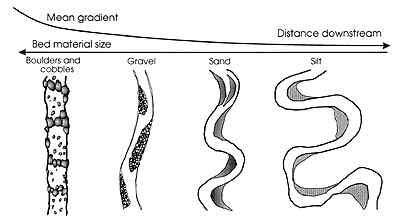 |
 |
Geomorphic Processes
Geomorphology is the study of the earthís surface forms and the processes and mechanisms that create these forms (Federal Interagency Stream Restoration Work Group, 1998). The hydrologic processes that characterize flowing water provide the mechanisms for the geomorphic processes discussed in this section. The three fundamental geomorphic processes associated with flowing water are erosion, sediment transport and sediment deposition.
As water flows along pathways in its watershed, it shapes the terrain through erosion, transport and deposition of sediments. Climate, topography, geology and land use influence the amount of sediment flowing through the watershed. Intense precipitation, steep slopes, easily erodible rock and soil, and land clearing all tend to increase sediment yields. In Minnesota, flowing water carries off more than 60 million tons of upland topsoil each year (Tester, 1995).
Stream transported sediment is classified either as suspended load or bedload. Suspended load consists of small particles such as clays, silts, and fine sands that are easily carried suspended in the flowing water. Bedload consists of large particles such as coarse sands, gravels and boulders that move by rolling, sliding, or hopping along the bed. River bed materials, referred to as the substrate, tend to vary downstream according to how easily the particles are transported (Figure 1.6). Beds of headwater streams usually contain large particles such as gravel and boulders that are too heavy for the stream to move. Downstream, the size of particles decreases, as large rocks are broken and worn down, and smaller particles such as finer sands and silts are sorted out, carried off and eventually deposited in the riverís delta. Natural and artificial obstructions in a stream cause localized changes in the streamís ability to transport particles.

Figure 1.6 Sediment Transport. Adapted from Church, M. 1992. Channel Morphology and Typology. Chapter 6 in The River Handbook, vol. 1, P. Calow and G.E. Petts, eds. pp. 130, 136.
The amount of sediment a river can transport depends on stream energy or power. Stream energy is a function of the velocity of its flow, the gradient of the channel and the channel depth. Other factors such as surface roughness also influence sediment transport. When stream energy is just sufficient to transport the sediment supplied to the river, the river is said to be in equilibrium, or graded. If an imbalance exists between the amount of sediment supplied to the river and streamís power to transport the sediment, the channel characteristics will change over time to bring the river system into equilibrium. When sediment supplied exceeds stream carrying capacity, sediment deposition builds up (or aggrades) the stream bed, increasing its slope downstream and thereby increasing stream power. In contrast, when a river can carry more sediment than it receives, Ďexcessí stream energy scours (or degrades) the channel, decreasing downstream slope and stream energy.